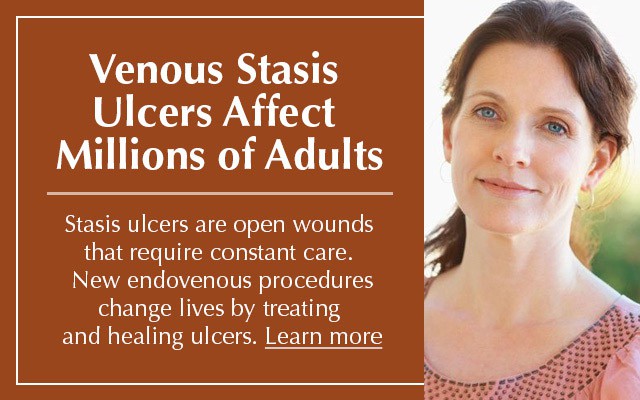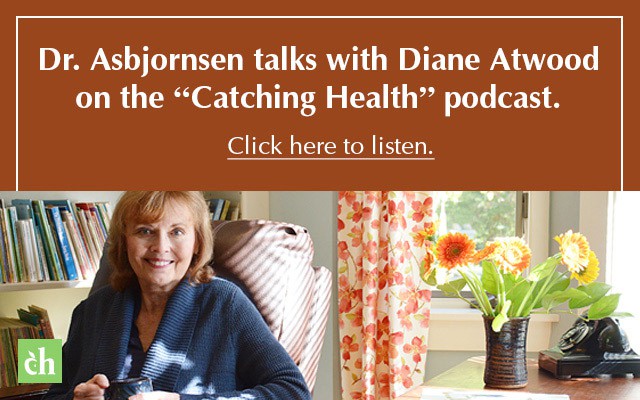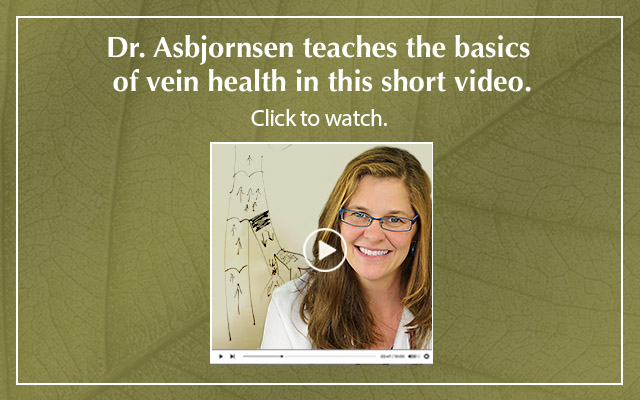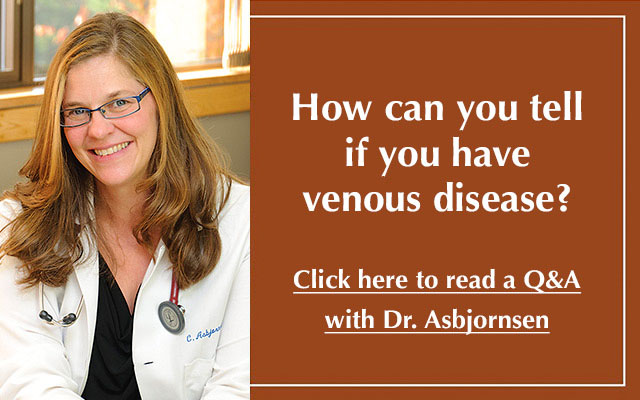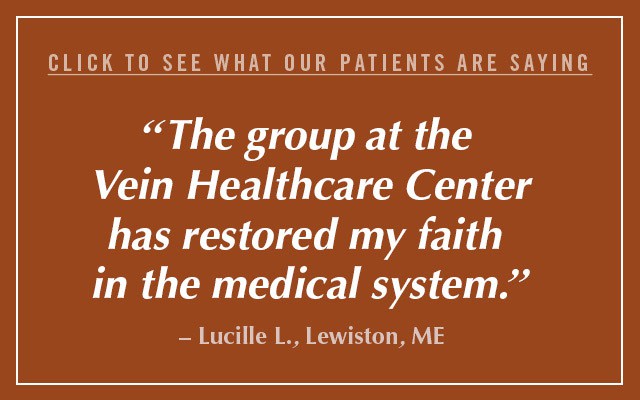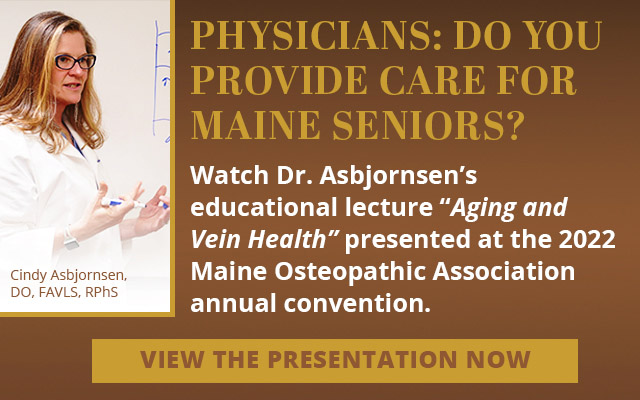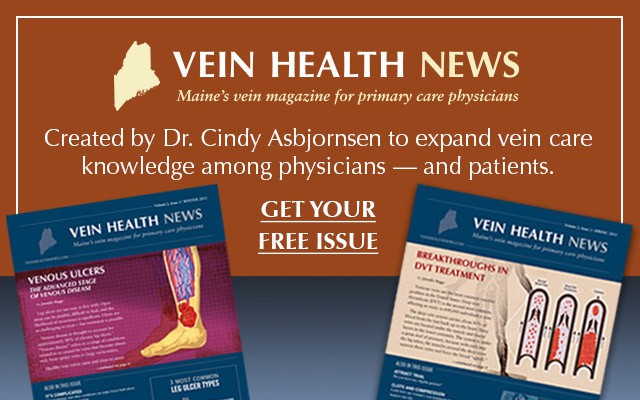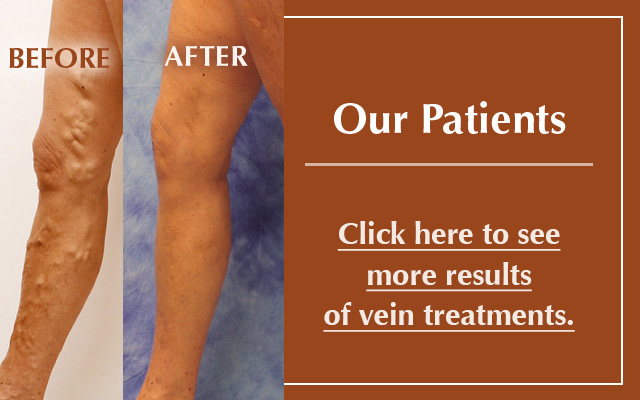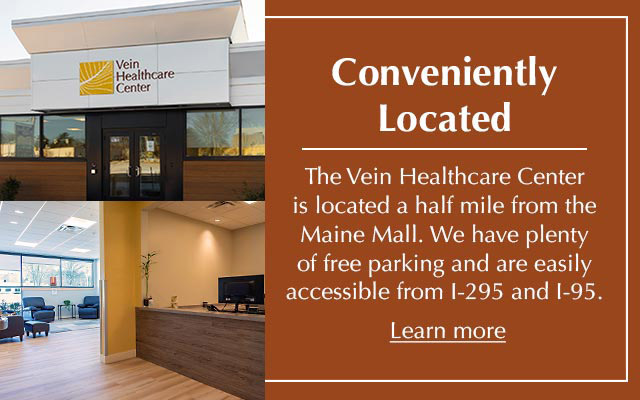About Venous Disease
Venous disease is defined as the impairment of blood flow towards your heart. Understanding venous disease means understanding the complex system of veins that make up our legs.
Our legs are comprised of a network of veins that are similar to branches on a tree: they contain large, or major veins and increasingly smaller veins. Oxygenated blood is constantly being pumped from the heart to the rest of our bodies through arteries. It is the job of our veins to carry deoxygenated blood back to the heart.
Healthy veins have valves which open and close to assist the return of blood to the heart. Venous disease (also called vein insufficiency or venous reflux), occurs if these valves become damaged, allowing the backward flow of blood in the legs. Because gravity works on the legs more than on other parts of the body, these vein walls are under tremendous pressure. When blood cannot be properly returned through the vein, it can pool, leading to a feeling of heaviness and fatigue, causing varicose veins and other skin changes.
Over time, this increased pressure can cause additional valves to fail. If left untreated, it can lead to leg pain, swelling, ulcers, and other health problems. If you think you have venous disease, talk to a certified phlebologist who can examine your legs and provide answers to your questions.
Approximately half of the U.S. population has venous disease.
Venous disease is one of the most common conditions affecting our health. Many have visible varicose veins, where others have no visible signs of the disease. It can affect men and women of all ages and activity levels, and while it has a strong genetic component, venous disease can be aggravated by environmental risks, pregnancy, and other factors.
Venous disease is a progressive disease that is not curable.
When people encounter any of the symptoms of venous disease, they should be considered early stage symptoms of a serious medical disorder, which, left untreated, can lead to worsening symptoms and complications to overall health and well-being. Long-standing varicose veins can lead to swelling. That means people with varicose veins are more likely to develop advanced symptoms such as increased pain, skin changes and ultimately, ulcers. Because of its progressive nature, treating venous disease is never simply cosmetic.
For most people, even debilitating symptoms are completely treatable.
Treatment can help manage venous disease by eliminating pain and improving appearance and overall health. Today's treatments are minimally-invasive, cause very little pain, and can be accomplished quickly right in a physician's office. Treatment can stop the progression of the disease and its complications for those in its early stages, and for those struggling with late-stage symptoms, it can restore health and quality of life.
Proper treatment means evaluating your complete venous system.
As part of complete, comprehensive care, it is critical that evaluation involves close attention to the entire venous system so poorly functioning veins can be treated at the source. Venous reflux can be an underlying cause of many symptoms, and because superficial veins are connected to the deeper venous system, valve failure that causes varicose veins can originate in a major vein, where treatment should be focused. Learn about Dr. Cindy Asbjornsen's comprehensive approach to vein care at the Vein Healthcare Center.
Find answers to common questions about venous disease.
Symptoms of Venous Disease
Spider Veins
Spider vein is the common term for blue or purple-colored veins that occur under the skin but are close enough to be seen on the surface. Spider veins can cause physical discomfort, but because of their appearance, they can be a source of embarrassment and self-consciousness, especially during the summer season. Spider veins are an indication of early stage venous disease, and treating them not only can improve appearance but can help stop the progression of venous disease. The classification used by most physicians to describe venous disease is called the CEAP scale. The C stands for “clinical severity,” on this scale spider veins are C 1.
Expand Your Knowledge: In the past, treatment of spider veins and varicose veins has often been considered cosmetic. Today, we know that leaving venous issues untreated can eventually lead to larger health problems.
Varicose Veins
Varicose veins are visible veins in the leg that bulge, often protruding through the skin. They are the result of venous insufficiency: blood that pools in the vein because of a faulty valve and causes the protrusion. Varicose veins are a symptom of early stage venous disease. Untreated, they can lead to increased symptoms and worsening appearance. Varicose veins affect approximately half of the U.S. population, and in addition to causing pain and discomfort, those with varicose veins struggle unnecessarily with their appearance. They often limit social activity and experience a significantly change in their quality of life. On the above mentioned CEAP scale varicose veins are C 2.
Expand Your Knowledge: Often, those who have varicose veins are concerned that the vein will bleed. In fact, a bleeding varicose vein is a very real concern. If your vein bleeds, elevate and hold continuous pressure for at least 10 minutes. If you can not get the bleeding to stop, seek immediate medical help.
Swelling
While symptoms of early stage venous disease are not always painful, it is common to experience discomfort as the disease progresses. This can manifest through fatigue or general discomfort that gets worse over the course of a day or after standing for long periods, and can often be relieved by elevating the legs. Some people with venous disorders have itchy skin or cramping in the legs, or legs that begin cramping after long periods of standing. Others experience restless leg syndrome, aching, or swelling. These symptoms can occur with or without the presence of visible veins, but are often accompanied by swelling.
Chronic swelling puts people at risk for cellulitis, a potentially serious bacterial skin infection that can affect the skin’s surface and its underlying tissue and cause the skin to become swollen and tender. Those with venous symptoms can also be at increased risk for phlebitis. These are clots within the superficial veins that can be extremely painful and often require weeks of inactivity while the leg heals. Swelling in the CEAP classification translates to C 3.
Expand Your Knowledge: Those experiencing restless leg syndrome may be experiencing a symptom of venous insufficiency. When restless leg occurs in conjunction with vein disorders, vein treatment can cause relief of symptoms and eliminate the need for medication.
Skin Changes
Skin changes can occur during many stages of venous disease. Swelling may occur around the leg, ankles, or around the knees. Brown discoloration that appears as a stain on the skin is a sign of an advanced stage of venous disease. This occurs as a result of blood leaking from the blood vessels and into the skin tissue. This staining can lead to white spots and are a precursor to an ulcer.
Other skin changes include lipodermosclerosis, a disease that causes the skin to thicken, and eczema, which causes the skin to become red or scaly. The changes in the skin are classified as C 4 on the CEAP scale.
Ulcers
Venous stasis ulcers in the leg are often an indication that venous disease has reached an advanced stage. Because venous disease is progressive, venous reflux can often lead to additional valve failure. As a result, the pooling of blood can affect a larger area. When blood pools in the lower leg over a long period of time, the condition is referred to as venous stasis.
When blood leaks into the tissue of the skin, it can cause swelling and damage to the tissue. Tissue damage can result in wounds, or ulcers, that are chronic and do not heal if the condition is left untreated. Ulcers may be painful or itchy and often require constant care and dressing. Because ulcers typically do not heal on their own, they can have a significant impact on quality of life. Those legs are classified as C5 when there is a healed ulcer or C6 if there is an open ulcer
Often, because of a poor understanding of options for treatment, people can be plagued with ulcers for years, assuming there is no alternative. While treating the source of venous disorders early can prevent ulcers, those who are already experiencing this late-stage symptom can have excellent success with treatment. In many cases, people with ulcers are able to enjoy complete healing and recovery.
Expand Your Knowledge: Ulcers can occur in the elderly or in people in their twenties. Long periods of sitting or stagnancy can cause venous reflux that leads to ulcers in any stage of life and, without treatment, can cause lifelong problems.
Other Complications of the Venous System
Superficial Thrombophlebitis
Superficial Venous Thrombophlebitis (SVT) is the term used for blood that becomes turbulent and pools near the surface of the skin, resulting in a clot in a superficial vein. Superficial refers to the veins just below the skin’s surface. Blood clotting and swelling in superficial veins rarely cause serious problems, but they can be extremely painful and lead to weeks of incapacitation while the leg heals. Frequent clots require treatment to fix the underlying venous insufficiency.
Most superficial veins develop dysfunction at junctions with deep veins. It is crucial to treat a vein at the source of the problem. A thorough “vein mapping” with ultrasound is a critical part of evaluation and treatment of SVT.
Deep Vein Thrombosis
Clots that occur in the deep vein system are called Deep Vein Thrombosis (DVT). This is a serious, life-threatening condition that requires immediate medical care. A clot in a deep vein can move through the bloodstream resulting in embolism. Many factors contribute to DVT risk including inherited disorders, certain medications or vein injuries. Sitting in a confined space or traveling for long periods can also increase the risk of DVT.
While symptoms of venous disease can increase the chances of experiencing SVT, DVT is not a symptom of the progression of venous disease. However, irritation of the vein wall, which occurs in SVT, can be a risk factor for DVT. Learn More
If you are having any of the above symptoms, seeing a professional vein specialist for a thorough evaluation will help you determine the severity of your issue and explore options for treatment.
Learn more about DVT and its ongoing research at the Centers for Disease Control and Prevention.
Your vein health affects your overall health. At the Vein Healthcare Center in Maine, we take a comprehensive approach to vein health. By evaluating your entire venous system, we can treat venous disorders at their source. If you are having any of the above symptoms, seeing a professional vein specialist for a thorough evaluation will help you determine the severity of your issue and explore options for treatment. Learn about your options for treatment of venous disease by visiting the Treatment Options page.
Expand Your Knowledge: DVT that results in an embolism can cause the immediate onset of extreme pain. However, over half of those who experience DVT experience no symptoms at all.
Dr. Cindy Asbjornsen is a certified phlebologist serving patients in Maine, New Hampshire, Massachusetts and Canada. Contact Dr. Asbjornsen at the Vein Healthcare Center to answer any questions you may have about your vein health.
 Request an Appointment
Request an Appointment
Ready to take the next step towards understanding your vein health and the available treatment options? Click here to request an appointment.
 Testimonials
Testimonials
See what some of our patients have to say about treatment at the Vein Healthcare Center. Click here to read more.
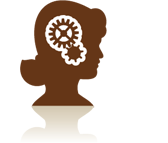
Expand your knowledge
of Venous Disease.
Learn more about the latest research, information, and resources at the Venous Health Links and Information section.
![]() Is the treatment of varicose veins covered by insurance?
Is the treatment of varicose veins covered by insurance?
Varicose veins are a symptom of progressive venous disease. Most insurance companies recognize venous therapy as a medical treatment and are thus covered by insurance. Read more.
![]() Have Venous Disease?
Have Venous Disease?
Get relief now. Read "10 Things you can do to ease your venous disease symptoms"
![]() Educational Video
Educational Video
Get practical, easy-to-understand explanations about vein treatment in this ACP-produced video. Click here to watch.













